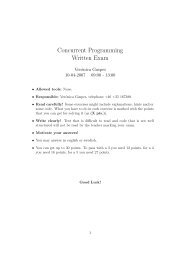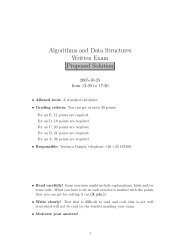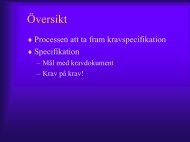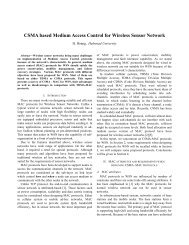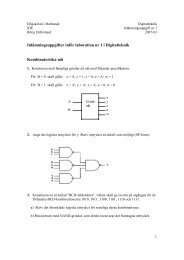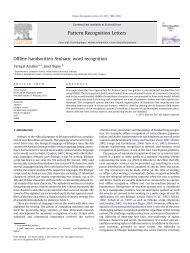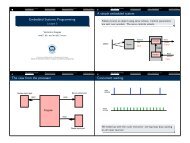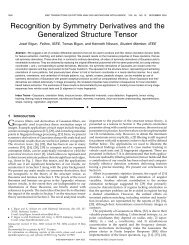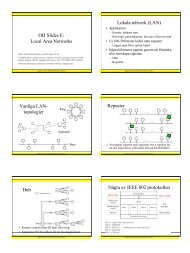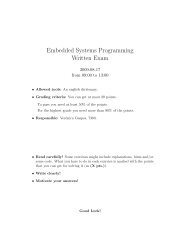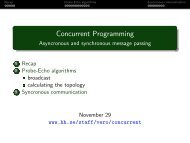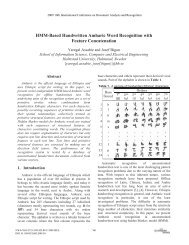handout
handout
handout
Create successful ePaper yourself
Turn your PDF publications into a flip-book with our unique Google optimized e-Paper software.
Another overview of the compiler<br />
Computer Languages<br />
Basic Blocks & Instruction Selection<br />
Verónica Gaspes<br />
School of Information Science, Computer and Electrical Engineering<br />
Source: unstructured text<br />
class A {<br />
public static void ...<br />
System.out.print(3);}<br />
class B {<br />
int x;<br />
int f(int y){<br />
return x+y;}}<br />
Intermediate representation<br />
MOVE<br />
MEM<br />
CONST(1)<br />
PLUS<br />
CONST(3) CONST(2)<br />
Target: unstructured text<br />
May 8<br />
www.hh.se/staff/vero/languages<br />
Abstract syntax: strucutured<br />
program<br />
mainclass classdecl classdecl classdecl<br />
methoddecl<br />
fielddecl fielddecl<br />
main:<br />
subu $sp, $sp, 32<br />
sw $ra, 20($sp)<br />
sd $a0, 32($sp)<br />
sw $0, 24($sp)<br />
sw $0, 28($sp)<br />
Mismatches between IR trees and machine-language<br />
Overview of the transformation<br />
◮ CJUMP(op,e 1 ,e 2 ,l 1 ,l 2 )! In real machines conditional jumps<br />
fall to the next instruction!<br />
◮ ESEQ(s,e) makes different evaluation orders yield different<br />
results!<br />
◮ CALL(f,e 1 ,. . . ,e n ) too!<br />
◮ CALL(f,e 1 ,. . . ,e n ) within other CALL() disturb using<br />
dedicated registers for parameters.<br />
Solution<br />
Transform the IR-trees preserving meaning but making them easier<br />
to translate to machine language!<br />
Canonical Trees<br />
The original IR-tree is transformed into a list of canonical trees<br />
without SEQ() or ESEQ() nodes<br />
Basic Blocks<br />
The list of canonical trees is grouped into a set of basic blocks<br />
such that there are no jumps or labels inside a block.<br />
Traces<br />
Finally, the basic blocks are reordered into a set of traces where<br />
each CJUMP() is immediatelly followed by its false label.
IR-trees (reminder)<br />
IR-trees are the abstract syntax for the abstract machine<br />
instruction language!<br />
Example<br />
const(1)<br />
temp(t 98 )<br />
jump(l 1 )<br />
binop(+,const(1),temp(t 98 ))<br />
move(temp(t 98 ),const(1))<br />
call(f,temp(t 98 ))<br />
mem(call(f,temp(t 98 )))<br />
move(mem( call(f,temp(t 98 ))),const(1))<br />
eseq(move( temp(t 98 ),const(1)),temp(t 98 ))<br />
tree.Exp<br />
const(1)<br />
temp(t 98 )<br />
binop(+,const(1),temp(t 98 ))<br />
call(f,temp(t 98 ))<br />
mem(call(f,temp(t 98 )))<br />
eseq(move( temp(t 98 ),const(1)),temp(t 98 ))<br />
Getting rid of eseq(s,e)<br />
tree.Stm<br />
jump(l 1 )<br />
move(temp(t 98 ),const(1))<br />
move(mem( call(f,temp(t 98 ))),const(1))<br />
IR-trees (remarks)<br />
◮ eseq(s,e)is very useful but introduces side effects when<br />
evaluating expressions!<br />
◮ Many computer architectures support parallel evaluation of<br />
expressions.To exploit this, the order of evaluation of<br />
expressions should not influence the result!eseq(s,e) spoils<br />
this!<br />
◮ We want to get rid of eseq(s,e) before generating code!<br />
◮ We will subject each fragment to transformations that<br />
preserve meaning and result in IR-trees that are easier to<br />
translate to assembler!<br />
Getting rid of eseq(s,e)<br />
Some transformations that move eseq(s,e) to top level<br />
◮ If eseq(s,e) is the main expression in a statement, as in<br />
we might replace it by<br />
jump(eseq(s,e))<br />
seq(s,jump(e))<br />
◮ So, if we manage to shift all eseq(s,e) to top level, then we<br />
can eliminate them! (we transform an IR-tree with an<br />
eseq(s,e) into another IR-tree that achieves the same results<br />
and does not contain the eseq(s,r))<br />
◮ We have to provide the transformations that do the shift of<br />
subexpressions eseq(s,e) to top level!<br />
eseq(s 1 ,eseq(s 2 ,e)) ⇒ eseq(seq(s 1 ,s 2 ),e)<br />
binop(op,eseq(s,e 1 ),e 2 ) ⇒ eseq(s,binop(op,e 1 ,e 2 ))<br />
binop(op,e 1 ,eseq(s,e 2 )) ⇒ eseq(s,binop(op,e 1 ,e 2 )) IF e 1 and s<br />
commute<br />
binop(op,e 1 ,eseq(s,e 2 )) ⇒<br />
eseq(seq( move( temp(t),e 1 ),s),binop(op,temp(t),e 2 ))<br />
And there are some more . . .
The algorithm<br />
The algorithm<br />
Extract subexpressions<br />
Given a Tree.Exp or a Tree.Stm the subexpressions can be<br />
extracted calling method<br />
abstract public LinkedList kids();<br />
that is implemented adequately in each subclass of Tree.Exp and<br />
of Tree.Stm .<br />
Example<br />
CALL(NAME(f),CONST(3),MEM( CONST(4))).kids()<br />
will yield the list<br />
[NAME(f),CONST(3),MEM(CONST(4))].<br />
Reorder<br />
A list of expressions can be reordered using the rewrite rules to one<br />
statement that does all the side effects and a list of expressions<br />
without ESEQ()s<br />
Example<br />
For the list<br />
[e 1 ,e 2 ,ESEQ(s,e 3 )]<br />
the statement s must be pulled to the left past e 1 and e 2 .<br />
If s commutes with e 1 and e 2 reordering will yield<br />
(s,[e 1 ,e 2 ,e 3 ]).<br />
If s does not commute with e 1 and e 2 reordering will yield<br />
(SEQ(MOVE(t 1 ,e 1 ),SEQ( MOVE(t 2 ,e 2 ),s)),[TEMP(t 1 ),TEMP(t 2 ),e 3 ])<br />
The algorithm<br />
IR-trees (remarks)<br />
Building up<br />
Once the expressions have been reordered they must be used to<br />
form back the corresponding Tree.Exp or Tree.Stm . That is why<br />
we find methods<br />
◮ public abstract Tree.Exp build(ExpList kids) in<br />
class Tree.Exp<br />
◮ public abstract Tree.Stm build(ExpList kids) in<br />
class Tree.Stm<br />
That are implemented adequtely in each of their subclasses.<br />
Example<br />
class BINOP extends Exp{<br />
public Exp build(ExpList kids){<br />
return new BINOP(binop,kids.head,kids.tail.head);}<br />
}<br />
◮ Another issue is the possibility of using call(f,args) as<br />
subexpressions.<br />
◮ All functions return their result in the dedicated register<br />
RV.Thus, in<br />
binop(op,call(. . . ),call(. . . ))<br />
the second call will overwrite RV before the operation can be<br />
executed!<br />
◮ All call(f,args) are replaced by<br />
eseq(move( temp(t),call(f,args)),temp(t))<br />
before eliminating eseq()s
IR-trees (remarks)<br />
IR-trees (remarks)<br />
◮ After these transformations, seq() nodes can only appear as<br />
children to other seq() nodes. As no expressions remain that<br />
have statements as children, and only the seq() statement<br />
has statements as children!<br />
◮ The transformation<br />
seq(seq(a,b),c)⇒seq(a,seq(b,c))<br />
can be used to linearize the sequence structure.<br />
◮ Now seq() nodes are redundant! we can as well have a list<br />
with the statements in the sequence!<br />
◮ To resume,<br />
◮ the translation phase resulted in an IR-tree statement for every<br />
method body,<br />
◮ the transformations sketched turned each such statement into<br />
a list of atomic statements without eseq() expression nodes.<br />
◮ Before producing assembler we will rearange the lists of<br />
statements so that all<br />
CJUMP(op,e 1 ,e 2 ,l t ,l f )<br />
are followed by the statement under l f<br />
(so that they can be translated with the more common<br />
jumps!)<br />
Basic blocks and traces<br />
Basic Blocks - the algorithm<br />
◮ To implement this last transformation of the list of<br />
statements,a bit of control flow analysis is done.<br />
◮ First, basic blocks of statements are identified and put<br />
together. A basic block is a list of statements where<br />
◮ the first statement is a label()<br />
◮ the last statement is a jump() or cjump()<br />
◮ there are no other label(), jump() or cjump() in it.<br />
a basic block is entered at the begining and exited at the end!<br />
◮ Basic blocks can be rearanged in any order without altering<br />
results!<br />
Splitting<br />
The list of canonical IR-trees corresponding to a function body is<br />
inspected from first to last element.<br />
◮ On a LABEL(), start a new block!<br />
◮ On a JUMP() or CJUMP(), end a block!<br />
◮ On any other statement, add it to the current block!<br />
Completing<br />
◮ If a block doesn’t end with a JUMP() or CJUMP() add to<br />
it a JUMP() to the label of the following block.<br />
◮ If a block doesn’t start with a LABEL(), create one and<br />
stick it to it!
Basic blocks and traces<br />
Basic blocks and traces<br />
◮ Basic blocks are put together into a traces.<br />
◮ A trace is a sequence of statements that could be executed<br />
sequentialy.<br />
◮ We want to produce a set of traces such that<br />
◮<br />
◮<br />
◮<br />
every basic block is in some trace,<br />
every cjump() is followed by its false label<br />
many jump()s are followed by the label they jump to (because<br />
they can then be eliminated!)<br />
◮ First, a covering set of traces is built by starting with an<br />
arbitrary block and adding its execution successors to the<br />
trace until there are no more successors to add. Then another<br />
trace is started.<br />
◮ Then these traces are further adjusted by considering the<br />
cjump()s in them:<br />
◮ A cjump() followed by its false label is left untouched.<br />
◮ For a cjump() followed by its true label, labels are switched<br />
and the condition negated.<br />
◮ For a cjump() followed by neither label<br />
a new label is invented l ′<br />
the cjump() is replaced by:<br />
cjump(op,e 1 ,e 2 ,l t ,l ′ )<br />
label(l ′ )<br />
jump(l f )<br />
The package canon<br />
The back-end<br />
There is an implementation of these transformations that comes<br />
with the book. For it to run with the rest of the compiler I’ve<br />
made some small modifications (you will get it with the<br />
distribution for part five of the project)<br />
package canon;<br />
Canon removes eseq(), assigns call() to registers and<br />
returns a list of atomic statements<br />
BasicBlocks puts together statements into basic blocks<br />
TraceSchedule puts together blocks into traces and flattens<br />
back to a list of statements<br />
source<br />
code<br />
Front End<br />
IR<br />
The back-end is also structured in phases!<br />
Back End<br />
IR IR Abstract<br />
Opt Instr. Sel. Reg. Alloc.<br />
Assembler<br />
machine<br />
code<br />
errors<br />
Assembler
A small minijava program<br />
Observation<br />
For the back-end we no longer look at minijava! We compile<br />
IR-trees to assembler.<br />
class A{<br />
public static void main(String[] a){<br />
System.out.println(new B().f(3).f());<br />
}<br />
}<br />
class B{<br />
int x;<br />
int y;<br />
public C f(int z){<br />
if(x
B f - after the transformations<br />
What is left: code generation<br />
LABEL L6<br />
CJUMP(LT,<br />
MEM(<br />
BINOP(PLUS,<br />
TEMP t64,<br />
CONST 0)),<br />
MEM(<br />
BINOP(PLUS,<br />
TEMP t64,<br />
CONST 4)),<br />
L0,L1)<br />
LABEL L1<br />
MOVE(<br />
MEM(<br />
BINOP(PLUS,<br />
TEMP t64,<br />
CONST 0)),<br />
BINOP(PLUS,<br />
TEMP t65,<br />
MEM(<br />
BINOP(PLUS,<br />
TEMP t64,<br />
CONST 0))))<br />
LABEL L2<br />
MOVE(<br />
TEMP t32,<br />
CALL(<br />
NAME _malloc,<br />
CONST 0,<br />
CONST 0))<br />
JUMP(<br />
NAME L5)<br />
LABEL L0<br />
MOVE(<br />
MEM(<br />
BINOP(PLUS,<br />
TEMP t64,<br />
CONST 0)),<br />
BINOP(PLUS,<br />
TEMP t65,<br />
CONST 1))<br />
JUMP(<br />
NAME L2)<br />
LABEL L5<br />
Purpose: Generate a file with assembler code for a target machine<br />
Instruction Selection<br />
◮ Study the instructions of the target architecture.<br />
◮ Program how to match each IR statement with machine<br />
instructions.<br />
◮ For each instruction keep a list of the temporaries used.<br />
Register Allocation<br />
◮ Build a flow graph where instructions are nodes and edges<br />
reflect usage of temporaries.<br />
◮ Color the graph to find independent temporaries.<br />
◮ Assign registers to instructions.<br />
Instruction Selection<br />
A simple instruction set<br />
◮ The assembler instructions of the target machine can be<br />
studied from the documentation following with the SPIM<br />
simulator (linked from the course’s homepage).<br />
◮ To develop the program assigning assembler instructions to IR<br />
statements, we follow the algorithm suitable for RISC<br />
architectures presented in the book:<br />
Maximal Munch<br />
◮<br />
◮<br />
◮<br />
Identify patterns of trees that are implemented by assembler<br />
instructions<br />
Tile the IR tree using these patterns so that all nodes in the<br />
tree are covered<br />
Output the sequence of instructions corresponding to the tiling<br />
ADD r i ← r j + r k<br />
MUL r i ← r j ∗ r k<br />
SUB r i ← r j − r k<br />
DIV r i ← r j /r k<br />
ADDI r i ← r j + c<br />
SUBI r i ← r j + c<br />
LOAD r i ← M[r j + c]<br />
STORE M[r j + c] ← r i<br />
MOVEM M[r j ] ← M[r i ]<br />
There are only arithmetic and<br />
memory instructions (no<br />
jumps!).<br />
r 0 is allways 0.
Identifying patterns<br />
Tiling<br />
Instruction<br />
r i<br />
Patterns<br />
temp()<br />
r i ← r j + r k binop(+, , )<br />
r i ← r j + c binop(+, ,const()) binop(+,const(), ) const()<br />
r i ← M[r j + c] mem(binop(+, ,const())) mem(const())<br />
r i ← M[r j + c] move(mem( binop(+, ,const())), ) move( ,mem( binop(+, ,const())))<br />
M[r j ] ← M[r i ] move(mem( ),mem( ))<br />
. . . . . .<br />
◮ View the tree patterns as tiles and cover the IR-tree that is<br />
being translated with nonoverlapping tiles.<br />
◮ Greedy algorithm:<br />
◮ Starting with the root of the IR tree find the largest tile that<br />
fits,<br />
◮ cover the root and subnodes matching the tile,<br />
◮ recursively apply the algorithm on all non-covered subtrees.<br />
◮ Examples on the whiteboard!<br />
Important<br />
All IR nodes should be covered by some pattern!<br />
Representing instructions<br />
Representing instructions<br />
◮ The result of instruction selection is a list of instructions.<br />
◮ An instruction can<br />
◮ be formatted: made into a string to contribute one line to the<br />
assembler file<br />
◮ return the list of registers it uses (sources) and the list of<br />
registers it modifies (destinations). These 2 lists are later used<br />
by the register allocator.<br />
◮ return the list of labels it jumps to.<br />
package assem;<br />
public abstract class Instr {<br />
public String assem;<br />
public Temp[] use;<br />
public Temp[] def;<br />
public String format(TempMap m) {...}<br />
}<br />
◮ The method for formatting takes as argument a table saying<br />
how registers should be represented as a string and produces a<br />
string for the instruction.<br />
◮ In the string containing the assembler instruction registers are<br />
named as strings but they have to be related to the registers<br />
in the lists use and def
Representing instructions<br />
Producing assembler instructions<br />
◮ One way of creating instructions is by using<br />
public class OPER extends Instr {<br />
public OPER(String a, Temp[] d, Temp[] s,<br />
List j) {<br />
...}<br />
}<br />
◮ By providing<br />
◮ a string with an assembler instruction with registers using<br />
codes, e.g. "add ’d0 ’s0 ’s1"<br />
◮ The lists of temporaries with sources and destinations to be<br />
matched with the codes. Some of the temporaries will be the<br />
result of the translation of IR-trees of subexpressions.<br />
◮ To recursively traverse an IR-tree we will use a visitor<br />
package tree;<br />
public interface CodeVisitor {<br />
public void visit(JUMP n);<br />
public void visit(CJUMP n);<br />
public void visit(MOVE n);<br />
...<br />
public Temp visit(BINOP n);<br />
public Temp visit(MEM n);<br />
public Temp visit(TEMP n);<br />
...<br />
◮ Notice the return type for visiting tree.Exp s.<br />
◮ When we recursively call the instruction generator (a code<br />
visitor) on a tree.Exp we get the register where it leaves the<br />
result!<br />
Producing assembler instructions<br />
Laboration 5<br />
◮ In the class generating instructions, say<br />
class Codegen implements tree.CodeVisitor<br />
◮ the patterns must be programmed<br />
◮ In Java we do this by restricting the argument to the visit<br />
method (longest patterns first!):<br />
public void visit(Tree.MOVE s) {<br />
// MOVE(MEM, Exp)<br />
if (s.dst instanceof Tree.MEM) {<br />
Tree.MEM mem = (Tree.MEM)s.dst;<br />
// MOVE(MEM(+ Exp CONST), Exp)<br />
if (mem.exp instanceof Tree.BINOP) {<br />
Tree.BINOP b = (Tree.BINOP)mem.exp;<br />
if (b.binop == Tree.BINOP.PLUS && immediate(b)) {<br />
...<br />
emit(OPER("sw ‘s0 " + off + "(‘s1)", null,<br />
new Temp[]{s.src.accept(this), left}));<br />
◮ You will have to program class Codegen implements<br />
tree.CodeVisitor<br />
◮ You get all classes in the package assem<br />
◮ You get a Main that calls on all the phases:<br />
◮ parsing<br />
◮ typechecking<br />
◮ intermediate code generation<br />
◮ transformations<br />
◮ instruction selection<br />
◮ You have to read the description of SPIM assembler (starting<br />
on page 54 of the manual).<br />
◮ You have to read the calling convention to know what<br />
registers to use (SPIM has dedicated registers!!)



